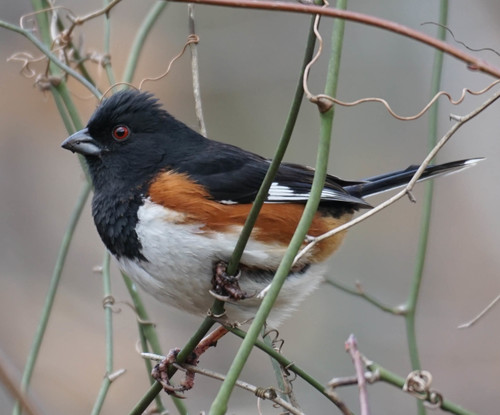
Eastern Towhee
The Eastern Towhee (Pipilo erythrophthalmus) is a striking, large sparrow native to eastern North America. Known for its bold black, white, and rufous plumage, it plays a crucial role in its ecosystem by dispersing seeds and controlling insect populations. It's often heard before it's seen, scratching vigorously in leaf litter with a distinctive two-footed backwards hop. While not holding major cultural significance like some birds, its recognizable call ("drink-your-tea!") and conspicuous foraging habits make it a familiar backyard species for many.
17-21 cm
Length
20-30 cm
Wingspan
Least Concern
Conservation Status
Distribution
Eastern Towhees are found across the eastern United States and southeastern Canada. Their range extends from southern Manitoba and Ontario, east to Nova Scotia, and south to Florida and the Gulf Coast. Some populations are migratory, with northern birds moving south for the winter, while southern populations are generally resident year-round. They are not typically found at high elevations.
Lifespan
Up to 10 years in the wild, though most live much shorter lives; 6-8 years is a more typical maximum.
Eastern Towhee's Habitat
Habitat Types
Forest edges, Thickets, Shrublands, Overgrown fields, Woodland clearings
Climate Zones
Temperate, Subtropical
Adaptations
Eastern Towhees have strong legs and feet adapted for scratching through leaf litter to find food. Their relatively short, rounded wings are suited for quick maneuvering through dense underbrush.
Variations
Several subspecies are recognized, differing subtly in plumage color and size. For example, birds in the southeastern coastal plain tend to have darker rufous flanks than those further inland.
Appearance
Breeding Plumage
Plumage is generally consistent year-round, although it may appear slightly brighter during the breeding season due to feather wear.
Seasonal Feather Changes
Minimal seasonal variation; fresh plumage after molting may be slightly brighter.
Sex Based Plumage Differences
Males have black upperparts, head, and breast, with rufous flanks and a white belly. Females have similar patterning but are brown where the males are black.
Notable Features
Bright red eyes (except in southeastern populations, where they are white), Long tail, often flicked or held erect, Rufous flanks contrasting with a white belly
Diet and Feeding
Primary Foods
Insects, Spiders, Seeds, Berries, Small fruits
Foraging Behavior
Eastern Towhees primarily forage on the ground, using a distinctive double-scratching technique. They hop backward, kicking both feet simultaneously to uncover food items hidden in leaf litter. They also glean insects from low vegetation.
Specializations
Their strong legs and feet are well-suited for their ground-foraging behavior. Their relatively heavy bill is capable of cracking seeds.
Seasonal Diet Variations
Diet shifts with seasonal availability. Insects and other invertebrates are dominant in spring and summer, while seeds and fruits become more important in fall and winter.
Behavior
Social Structure
Generally solitary or found in pairs during the breeding season. They may form loose flocks during the non-breeding season, particularly at abundant food sources.
Communication
A characteristic "chewink" or "towhee" call, A complex song consisting of a series of musical trills and whistles, often starting with a "drink-your-tea" phrase, Wing-flicking and tail-flicking displays
Migration
Northern populations are migratory, moving south to the southern United States and Mexico for the winter. Southern populations are mostly resident.
Territorial or Group Behaviors
Males are strongly territorial during the breeding season, defending their nesting area against rivals. They are less territorial during the non-breeding season.
Conservation
Threats
Habitat loss and fragmentation due to development and agriculture, Nest predation by snakes, raccoons, and other animals, Brood parasitism by Brown-headed Cowbirds, Collisions with windows and vehicles
Protection Programs
Habitat conservation and restoration efforts, Management of Brown-headed Cowbird populations in some areas
Local National Laws
Protected under the Migratory Bird Treaty Act in the United States.
Population Trend
Stable
Population Estimates
Global population estimated at 43 million.
Interesting Facts
Eastern Towhees were once known as "Chewinks" due to their distinctive call.
This onomatopoeic name reflects the sound of their most common vocalization.
The white-eyed form found in the southeastern US was once considered a separate species.
Genetic and behavioral studies have since shown it to be a regional variation of the Eastern Towhee.
Towhees will occasionally engage in 'anting'.
This is a behavior where birds rub ants (or other insects) on their feathers, possibly to remove parasites or soothe irritated skin.
Faqs about Eastern Towhee
What should I do if I find a baby Eastern Towhee?
If the bird is uninjured and appears healthy, it's best to leave it alone. The parents are likely nearby and will continue to care for it. If it's clearly injured or in immediate danger, contact a local wildlife rehabilitator. *Consult a professional for expert advice.*
How can I attract Eastern Towhees to my yard?
Provide dense, shrubby vegetation for cover and foraging. Offer seed mixes containing millet and sunflower seeds on the ground or in low platform feeders. A birdbath with fresh water can also be attractive.
Are Eastern Towhees aggressive?
Males can be aggressive towards other males during the breeding season when defending territories. However, they are generally not aggressive towards humans.
Why do towhees scratch at the ground?
They are looking for food. Their double-scratch technique is a very effective way to uncover insects, spiders, and seeds hidden in the leaf litter.
Copyright @ Nature Style Limited. All Rights Reserved.
 English
English